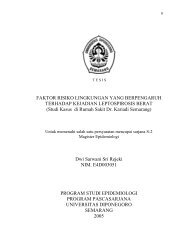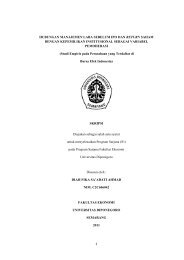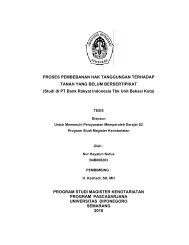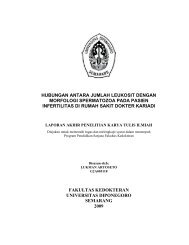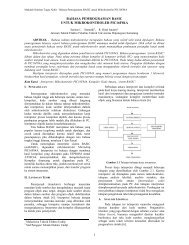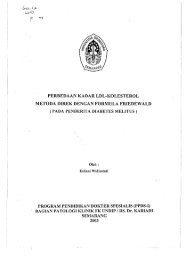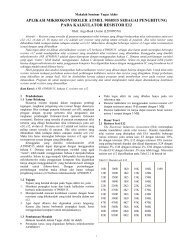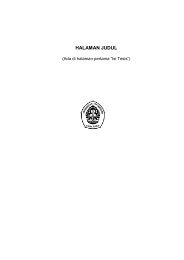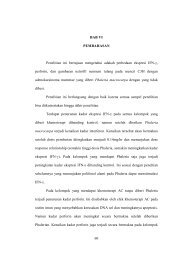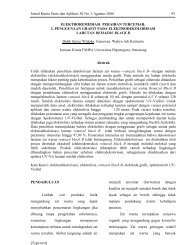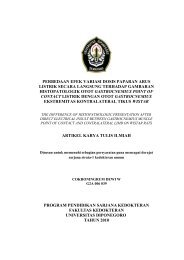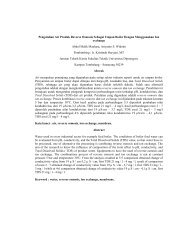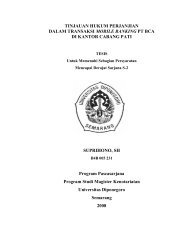Organizing Knowledge in Implementation of Knowledge ...
Organizing Knowledge in Implementation of Knowledge ...
Organizing Knowledge in Implementation of Knowledge ...
You also want an ePaper? Increase the reach of your titles
YUMPU automatically turns print PDFs into web optimized ePapers that Google loves.
Proceed<strong>in</strong>gs <strong>of</strong> The 1 st International Conference on Information Systems For Bus<strong>in</strong>ess Competitiveness (ICISBC) 2011<br />
Image: <strong>Knowledge</strong> Management Model (Construction Researcher)<br />
Review <strong>of</strong> Personnel Characteristics KM<br />
For a long time, research <strong>in</strong> the field <strong>of</strong><br />
management and organizations also <strong>of</strong>ten use <strong>in</strong>formation<br />
technology as a central <strong>in</strong>formation system (SI). One theory<br />
is the importance <strong>of</strong> <strong>in</strong>formation richness theory (IRT)<br />
which stated Daft & Lengel (1979). At first, the IRT is<br />
formulated to help to answer the question, "Why<br />
organizations need to process <strong>in</strong>formation?". The first<br />
def<strong>in</strong>ition <strong>of</strong> <strong>in</strong>formation richness itself, taken from a quote<br />
the orig<strong>in</strong>al formulation, is an ability to change the<br />
understand<strong>in</strong>g <strong>of</strong> <strong>in</strong>formation <strong>in</strong> a short time. However, this<br />
theory is considered have a shift <strong>in</strong> the def<strong>in</strong>ition <strong>of</strong><br />
<strong>in</strong>formation richness conta<strong>in</strong>ed <strong>in</strong> the e-mail. IRT also has<br />
received much criticism for <strong>in</strong>itially mov<strong>in</strong>g on context <strong>of</strong><br />
the organization <strong>in</strong>to the context <strong>in</strong>dividuals and the media.<br />
And it takes not only the media but also the <strong>in</strong>teractions that<br />
occur there<strong>in</strong>. From a number <strong>of</strong> empirical studies <strong>of</strong> the<br />
theory, it is obta<strong>in</strong>ed that the use <strong>of</strong> multiple communication<br />
media are not consistent with the theory <strong>of</strong> IRT.<br />
Consequently the argument to reject the idea that the<br />
richness communication is <strong>in</strong>variant, and only as a property<br />
<strong>of</strong> the communication medium itself. So that it appears the<br />
media richness theory (Media Richness Theory)<br />
Studies <strong>of</strong> communication richness <strong>in</strong> electronic<br />
media can be classified <strong>in</strong>to positivism and <strong>in</strong>terpretive<br />
research. Positivism is essentially a model <strong>of</strong> natural science<br />
applied research <strong>in</strong> the field <strong>of</strong> social science. Based on this<br />
perspective, the <strong>in</strong>teraction face-to-face is considered as the<br />
richest medium <strong>of</strong> communication and <strong>in</strong>teraction through e-<br />
mail as the most impoverished. Know<strong>in</strong>g the limitations <strong>of</strong><br />
positivism perspective, some researchers have <strong>in</strong>troduced<br />
the Information System <strong>of</strong> the new perspective <strong>of</strong> look<strong>in</strong>g at<br />
communication richness, <strong>in</strong>terpretive perspective. This<br />
perspective determ<strong>in</strong>e the capacity <strong>of</strong> the sender and<br />
receiver to process the message. The central idea <strong>of</strong> this<br />
perspective is the understand<strong>in</strong>g <strong>of</strong> both parties who<br />
exchange messages. They are actively and creatively<br />
<strong>in</strong>terpret the message <strong>of</strong> its bus<strong>in</strong>ess associates, especially<br />
those associated with process <strong>of</strong> <strong>in</strong>novation, to create new<br />
ideas about the realities faced on the job. In fact, they <strong>of</strong>ten<br />
make specific communities to discuss an issue, not only<br />
<strong>in</strong>volve <strong>in</strong>ternal members <strong>of</strong> the organization's but also<br />
external parties. Proper personal characteristics are<br />
possessed by Management Information personnel, <strong>in</strong><br />
addition to master<strong>in</strong>g knowledge and availability <strong>of</strong> data<strong>in</strong>formation-knowledge<br />
is also necessary competencies that<br />
a person is able to empower other members <strong>of</strong> his<br />
organization. It is like a consultant, not as an executive <strong>in</strong><br />
the path <strong>of</strong> bureaucratic l<strong>in</strong>es. He should be humble not<br />
appear <strong>in</strong> front, but rather to contribute from beh<strong>in</strong>d. The<br />
term <strong>in</strong> Javanese: “tut wuri handayani” or go beh<strong>in</strong>d while<br />
empower<strong>in</strong>g bureaucrats and bureaucracy. This mentality<br />
does not just belong to someone, but must be tra<strong>in</strong>ed, and<br />
this is the good "heart management". Managers should listen<br />
more and f<strong>in</strong>d effective solutions based on theoretical<br />
approachment that is mastered by them. He should be able<br />
to listen and identify the essence <strong>of</strong> the problem, whether it<br />
is rooted <strong>in</strong> the process, people or technology. In connection<br />
with the organization <strong>of</strong> KM, so <strong>in</strong> various companies it<br />
have emerged a variety <strong>of</strong> varieous positions names <strong>in</strong> units<br />
<strong>of</strong> KM. Some nam<strong>in</strong>g <strong>of</strong> the position <strong>in</strong> KM and its function<br />
is described as follows:<br />
1. CKO, is the supreme head <strong>of</strong> knowledge management<br />
<strong>in</strong> a company that is responsible for:<br />
2. Creat<strong>in</strong>g a knowledge management vision<br />
352



